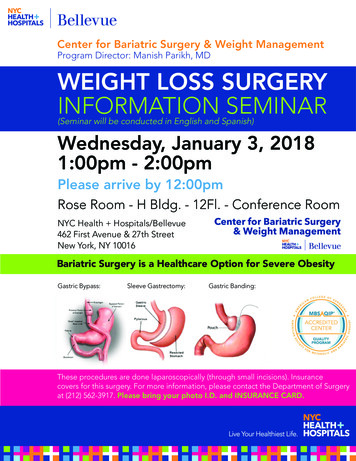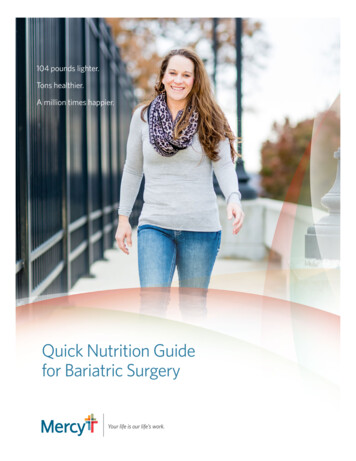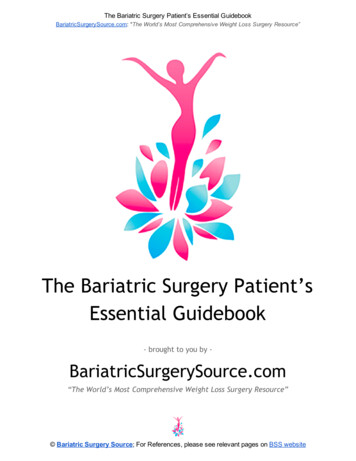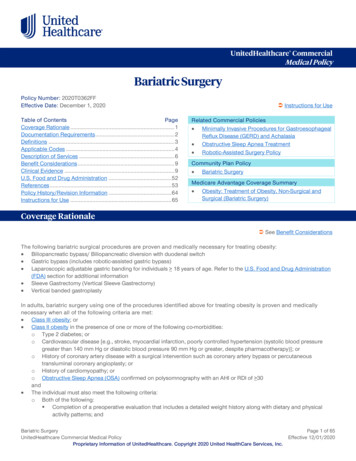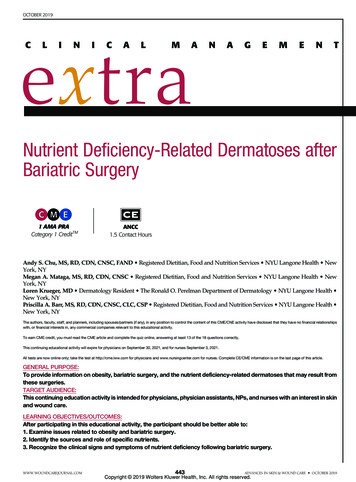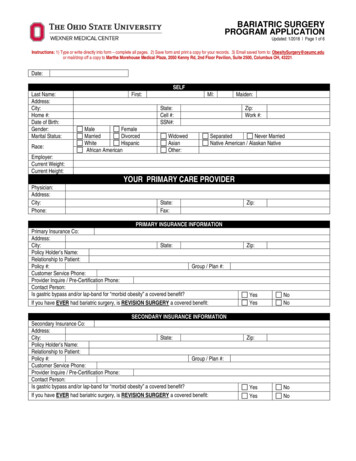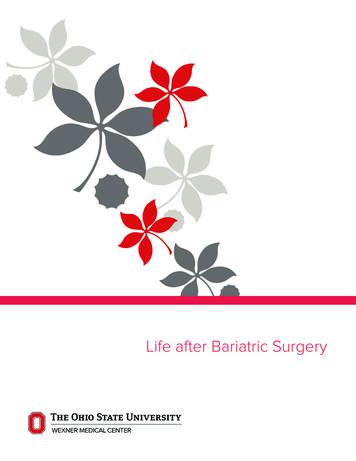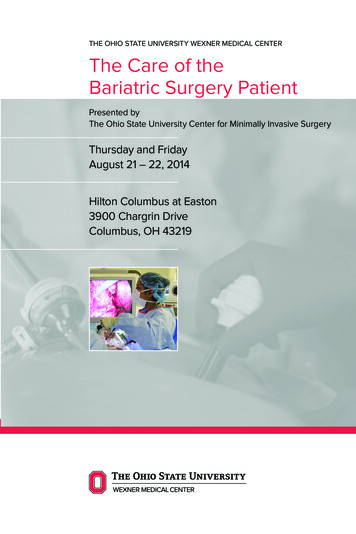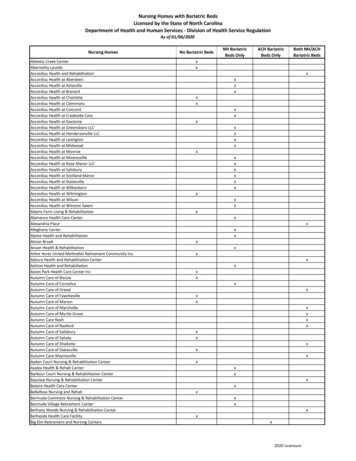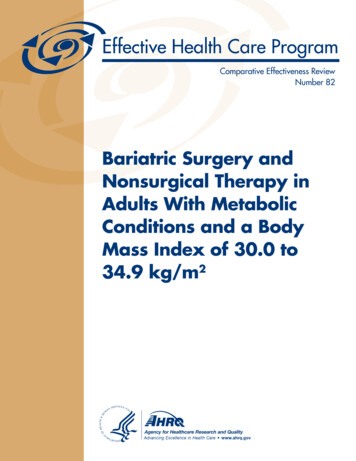
Transcription
Comparative Effectiveness ReviewNumber 82Bariatric Surgery andNonsurgical Therapy inAdults With MetabolicConditions and a BodyMass Index of 30.0 to34.9 kg/m2
Comparative Effectiveness ReviewNumber 82Bariatric Surgery and Nonsurgical Therapy in AdultsWith Metabolic Conditions and a Body Mass Indexof 30.0 to 34.9 kg/m²Prepared for:Agency for Healthcare Research and QualityU.S. Department of Health and Human Services540 Gaither RoadRockville, MD 20850www.ahrq.govContract No. 290-2007-10062-IPrepared by:Southern California Evidence-based Practice CenterSanta Monica, CAInvestigators:Margaret A. Maglione, M.P.P.Melinda Maggard Gibbons, M.D.Masha Livhits, M.D.Brett Ewing, M.S.Jianhui Hu, M.P.P.Alicia Ruelaz Maher, M.D.Zhaoping Li, M.D. Ph.D.Tanja Perry, B.H.M.Paul G. Shekelle, M.D., Ph.D.AHRQ Publication No. 12(13)-EHC139-EFJune 2013
Addendum - Bariatric Surgery and Nonsurgical Therapy in Adults With MetabolicConditions and a Body Mass Index of 30.0 to 34.9 kg/m²As part of the preparation of a paper to appear in the Journal of the American MedicalAssociation (JAMA), we added to our analysis two additional elements:1. We updated our literature search through September 2012. This resulted in includingeight additional surgical observational studies (1-8 below).2. We attempted to compare the weight loss and glucose control outcomes of bariatricsurgery with nonsurgical therapy in the two RCTs that directly compared these in patientswith diabetes for only those patients with a body mass index (BMI) of 30.0 to 34.9 kg/m2.The mean baseline BMI was 37.0 kg/m2 in both RCTs. For the trial reported by Schauerand colleagues, we used the results of an analysis presented as supplemental materialwith their original publication. This analysis found no statistically significant evidencethat the study outcomes differed in patients above and below the mean BMI of 37 kg/m2.For the trial reported by Dixon and colleagues, we obtained patient-level data from theauthors, and compared weight loss and glucose outcomes in the 13 patients included inthat trial that had a BMI of less than 35 kg/m2. There were statistically significantly betterweight loss and glucose control outcomes in the patients treated with bariatric surgerycompared to those treated nonsurgically.These additions did not change our conclusions regarding the effectiveness and safety bariatricsurgery in this population.For further information, see:Maggard-Gibbons M, Maglione M, Livhits M, et al. Bariatric surgery for weight loss andglycemic control in nonmorbidly obese adults with diabetes: a systematic review. JAMA. 2013June 5;309(21):2250-2261. DOI 10.1001/jama.2013.4851.References:1.Abbatini F, Capoccia D, Casella G, CocciaF, Leonetti F, Basso N. Type 2 diabetes inobese patients with body mass index of 3035 kg/m2: sleeve gastrectomy versusmedical treatment. Surg Obes Relat Dis.2012 Jan-Feb;8 (1):20-4. PMID 21924686.3.Cohen RV, Pinheiro JC, Schiavon CA,Salles JE, Wajchenberg BL, Cummings DE.Effects of gastric bypass surgery in patientswith type 2 diabetes and only mild obesity.Diabetes Care. 2012 Jul;35 (7):1420-8.PMID 22723580.2.Boza C, Munoz R, Salinas J, et al. Safetyand efficacy of Roux-en-Y gastric bypass totreat type 2 diabetes mellitus in non-severelyobese patients. Obes Surg. 2011 Sep;21(9):1330-6. PMID 21744283.4.Gianos M, Abdemur A, Fendrich I, Gari V,Szomstein S, Rosenthal RJ. Outcomes ofbariatric surgery in patients with body massindex 35 kg/m2. Surg Obes Relat Dis. 2012Jan-Feb;8 (1):25-30. PMID 22019140.ii
5.Kim MK, Lee HC, Lee SH, et al. Thedifference of glucostatic parametersaccording to the remission of diabetes afterRoux-en-Y gastric bypass. Diabetes MetabRes Rev. 2012 Jul;28 (5):439-46. PMID22407971.6.Lee WJ, Hur KY, Lakadawala M, KasamaK, Wong SK, Lee YC. Gastrointestinalmetabolic surgery for the treatment ofdiabetic patients: a multi-institutionalinternational study. J Gastrointest Surg.2012 Jan;16 (1):45-51; discussion -2. PMID22042564.iii7.Sun ZC, Yu WS, Na Y, et al. ModifiedRoux-en-Y gastric bypass for type 2diabetes mellitus in China.Hepatogastroenterology. 2012 Jul 25;60(121) PMID 22829557.8.Zhu L, Mo Z, Yang X, et al. Effect oflaparoscopic Roux-en-Y gastroenterostomywith BMI 35 kg/m2 in type 2 diabetesmellitus. Obes Surg. 2012 Oct;22 (10):15627. PMID 22692669.
This report is based on research conducted by the Southern California Evidence-based PracticeCenter (EPC) under contract to the Agency for Healthcare Research and Quality (AHRQ),Rockville, MD (Contract No. 290-2007-10062-I). The findings and conclusions in this documentare those of the author(s), who are responsible for its contents; the findings and conclusions donot necessarily represent the views of AHRQ. Therefore, no statement in this report should beconstrued as an official position of AHRQ or of the U.S. Department of Health and HumanServices.The information in this report is intended to help health care decisionmakers—patients andclinicians, health system leaders, and policymakers, among others—make well-informeddecisions and thereby improve the quality of health care services. This report is not intended tobe a substitute for the application of clinical judgment. Anyone who makes decisions concerningthe provision of clinical care should consider this report in the same way as any medicalreference and in conjunction with all other pertinent information, i.e., in the context of availableresources and circumstances presented by individual patients.This report may be used, in whole or in part, as the basis for development of clinical practiceguidelines and other quality enhancement tools, or as a basis for reimbursement and coveragepolicies. AHRQ or U.S. Department of Health and Human Services endorsement of suchderivative products may not be stated or implied.This document is in the public domain and may be used and reprinted without permission exceptthose copyrighted materials that are clearly noted in the document. Further reproduction of thosecopyrighted materials is prohibited without the specific permission of copyright holders.Persons using assistive technology may not be able to fully access information in this report. Forassistance, contact EffectiveHealthCare@ahrq.hhs.gov.None of the investigators have any affiliations or financial involvement that conflicts with thematerial presented in this report.Suggested citation: Maglione MA, Maggard Gibbons M, Livhits M, Ewing B, Hu J, RuelazMaher A, Li Z, Perry T, Shekelle PG. Bariatric Surgery and Nonsurgical Therapy in Adults WithMetabolic Conditions and a Body Mass Index of 30.0 to 34.9 kg/m². Comparative EffectivenessReview No. 82. (Prepared by the Southern California Evidence-based Practice Center underContract No. 290-2007-10062-I.) AHRQ Publication No. 12(13)-EHC139-EF. Rockville, MD:Agency for Healthcare Research and Quality. June l.cfm.iv
PrefaceThe Agency for Healthcare Research and Quality (AHRQ), through its Evidence-basedPractice Centers (EPCs), sponsors the development of systematic reviews to assist public- andprivate-sector organizations in their efforts to improve the quality of health care in the UnitedStates. These reviews provide comprehensive, science-based information on common, costlymedical conditions, and new health care technologies and strategies.Systematic reviews are the building blocks underlying evidence-based practice; they focusattention on the strength and limits of evidence from research studies about the effectiveness andsafety of a clinical intervention. In the context of developing recommendations for practice,systematic reviews can help clarify whether assertions about the value of the intervention arebased on strong evidence from clinical studies. For more information about AHRQ EPCsystematic reviews, see .cfmAHRQ expects that these systematic reviews will be helpful to health plans, providers,purchasers, government programs, and the health care system as a whole. Transparency andstakeholder input are essential to the Effective Health Care Program. Please visit the Web site(www.effectivehealthcare.ahrq.gov) to see draft research questions and reports or to join anemail list to learn about new program products and opportunities for input.We welcome comments on this systematic review. They may be sent by mail to the TaskOrder Officer named below at: Agency for Healthcare Research and Quality, 540 Gaither Road,Rockville, MD 20850, or by email to epc@ahrq.hhs.gov.Carolyn M. Clancy, M.D.DirectorAgency for Healthcare Research and QualityJean Slutsky, P.A., M.S.P.H.Director, Center for Outcomes and EvidenceAgency for Healthcare Research and QualityStephanie Chang M.D., M.P.H.Director, EPC ProgramCenter for Outcomes and EvidenceAgency for Healthcare Research and QualityMary Nix M.S., M.T.(A.S.C.P.), S.B.B., P.M.P.Task Order OfficerCenter for Outcomes and EvidenceAgency for Healthcare Research and Qualityv
AcknowledgmentsThe authors gratefully acknowledge Roberta Shanman, M.L.S., who was instrumental insupporting the EPC team’s effort to find and obtain relevant literature. The authors alsogratefully acknowledge the following individuals for their contributions to this project:Key InformantsCaroline M. Apovian, M.D., FACP, FACNBoston University School of MedicineBoston, MAJohn Morton, M.D., M.P.H., FACSStanford School of MedicineStanford, CAPam Davis, R.N., CBN, CCMCentennial Center for the Treatment ofObesityNashville, TNJoe NadglowskiPresident and CEOObesity Action CoalitionTampa, FLJim Fivecoat, M.B.A.Member, Obesity Action CoalitionTaylors, SCJamshid Nazarian, M.D., FACSBeverly Hills, CAChuck Stemple, M.D.HumanaCincinnati, OHJeff HaagaMember, Obesity Action CoalitionWest Jordan, UTMonali Misra, M.D., FRCSC, FACSDr. Feiz and AssociatesBeverly Hills, CAvi
Technical Expert PanelCaroline M. Apovian, M.D., FACP, FACNBoston University School of MedicineBoston, MAEdward Harry Livingston, M.D., FACS, UTSouthwestern Medical CenterDallas, TXGeorge Bray, M.D.Pennington Biomedical ResearchFoundationBaton Rouge, LAJohn Morton, M.D., M.P.H., FACSStanford School of MedicineStanford, CAChristine J. Ren-Fielding, M.D.NYU Langone Medical CenterNew York, NYJohn B Dixon, M.B.B.S., Ph.D., FRACGPMonash University, Baker IDI Heart andDiabetes InstituteMelbourne, AustraliaBruce Wolfe, M.D.Oregon Health & Science UniversityPortland, ORDavid Heber, M.D.Ronald Reagan UCLA Medical CenterLos Angeles, CAPeer ReviewersDavid Arterburn, M.D., M.P.H.University of WashingtonSeattle, WAJames Hill, Ph.D.University of ColoradoDenver, COAlison Avenell, Ph.D.University of AberdeenAberdeen, Scotland, U.K.Joe NadglowskiPresident and CEOObesity Action CoalitionTampa, FLScott A. Cunneen, M.D.Cedars-Sinai Medical CenterLos Angeles, CAKen Fujioka, M.D.Scripps Clinic Del MarSan Diego, CAvii
Bariatric Surgery and Nonsurgical Therapy in AdultsWith Metabolic Conditions and a Body Mass Indexof 30.0 to 34.9 kg/m²Structured AbstractObjectives. To systematically review the scientific evidence on efficacy, safety, and comparativeeffectiveness of various types of bariatric surgery for treating adult patients with a body massindex (BMI) of 30.0 to 34.9 kg/m² and diabetes or impaired glucose tolerance (IGT) and tocompare effectiveness of surgery versus nonsurgical interventions in this population.Data sources. Systematic reviews, case series, cohort, case control studies and controlled trials,found through searching PubMed , Embase, CINAHL, Cochrane Central Register of ControlledTrials (CENTRAL), Cochrane Database of Abstracts of Reviews of Effects (DARE), andClinicaltrials.gov through March, 2012.Review methods. To be included, studies had to report on laparoscopic adjustable gastricbanding (LAGB), Roux-en-Y gastric bypass (RYGB), biliopancreatic diversion with duodenalswitch (BPD), sleeve gastrectomy (SG), or nonsurgical treatment, and had to include patientswith a BMI of at least 30 kg/m2 but less than 35 kg/m² with diabetes or IGT. The followingstudies were excluded: (1) those with no outcomes of efficacy, effectiveness, or safety/adverseevents; (2) nonsurgical studies with less than one year followup; (3) nonsurgical studies alreadyincluded in previous systematic reviews; and (4) studies with a sample size of less than three.Two reviewers, each trained in the critical analysis of scientific literature, independentlyreviewed and abstracted each study.Results. We found only 24 studies reporting bariatric surgery results in this specific targetpopulation. Two were trials comparing different procedures, three were trials of surgical versusnonsurgical interventions, and the rest were observational studies. Both weight and bloodglucose improved significantly for surgery patients in the trials. In the observational studies,surgery patients showed much greater weight loss at 1 year than reported in systematic reviewsand randomized controlled trials (RCTs) on diet, exercise, medication, and other behavioralinterventions. While both behavioral interventions and medications lowered HbA1c(glycosylated hemoglobin) levels significantly, the decreases reported in surgery patients weremuch greater. Improvements in blood glucose measures were reported as early as one monthpostsurgery. Improvements in hypertension, low-density lipoprotein (LDL) cholesterol, andtriglycerides were also reported in some studies. Short-term rates of adverse events associatedwith bariatric surgery were relatively low. One death, a case of sepsis at 20 months in an LAGBpatient, was reported. Short-term complications were minor and tended not to require majorintervention. Due to the dearth of long-term studies of bariatric surgery in this particular targetpopulation, few data exist about long-term adverse effects, and we found no evidence regardingmajor clinical endpoints such as all-cause mortality, cardiovascular mortality and morbidity, andperipheral arterial disease.Conclusions. According to blood glucose outcomes, there is moderate strength evidence ofefficacy for RYGB, LAGB, and SG as treatment for diabetes and IGT in patients with a BMIviii
between 30 kg/m2 and 35 kg/m2 in the short term (up to 2 years). The strength of evidence forBPD is rated low because there are fewer studies, and these have smaller sample sizes. Evidenceon comparative effectiveness of surgical procedures is insufficient. Short-term adverse events arerelatively minor; strength of evidence is low due to small sample size with low power to detectrare events. Strength of evidence is insufficient regarding adverse events in the long-term (2years or more postsurgery). Longitudinal studies of bariatric surgery patients are needed to assessoverall safety and comparative effectiveness regarding diabetes-related morbidity such as kidneyfailure and blindness.ix
ContentsExecutive Summary .ES-1Introduction .1Conventional Therapy for Obesity and Diabetes .2Diet.2Exercise .2Behavior Modification .2Medications .2Bariatric Surgery .3Gastric Bypass (RYGB) .3Laparoscopic Adjustable Gastric Band (LAGB) .4Sleeve Gastrectomy .4Biliopancreatic Division/Duodenal Switch (BPD) .4Bariatric Surgery in Lower Weight Patients .5Methods.6Original Proposed Key Questions (KQs) .6Technical Expert Panel .6Analytic Framework .6Literature Search .7Article Review .8Study Inclusion .8Screening.9Data Abstraction and Synthesis of Results .9Assessment of Methodological Quality .9Grading the Evidence for Each KQ .10Peer Review and Public Commentary .12Results .13KQ1: What does the evidence show regarding the comparative effectivenessof bariatric surgery for treating adult patients with BMI of 30 to 34.9 andmetabolic conditions, including diabetes? Are certain surgical proceduresmore effective than others (laparoscopic adjustable gastric banding, gastricbypass, or sleeve gastrectomy)? .15KQ2: What does the evidence show regarding the comparative effectivenessof bariatric surgery versus conventional nonsurgical therapies for treatingadult patients with BMI of 30 to 34.9 and metabolic conditions? .15Head-to-Head Trials of Bariatric Surgery Versus Nonsurgical Interventions .17Head-to-Head Trials of Surgical Procedures .20Observational Studies With Surgical Procedure Comparisons.21Small Cohorts: Surgery Versus Nonsurgical Interventions .22Observational Studies—Diabetes Outcomes .22Observational Studies—Other Health Outcomes .30Systematic Reviews on Behavioral Interventions.31Systematic Reviews on Diabetes Medications .34Major Trials Published After the Systematic Reviews .36Summary .
effectiveness of various types of bariatric surgery for treating adult patients with a body mass index (BMI) of 30.0 to 34.9 kg/m² and diabetes or impaired glucose tolerance (IGT) and to compare effectiveness of surgery
